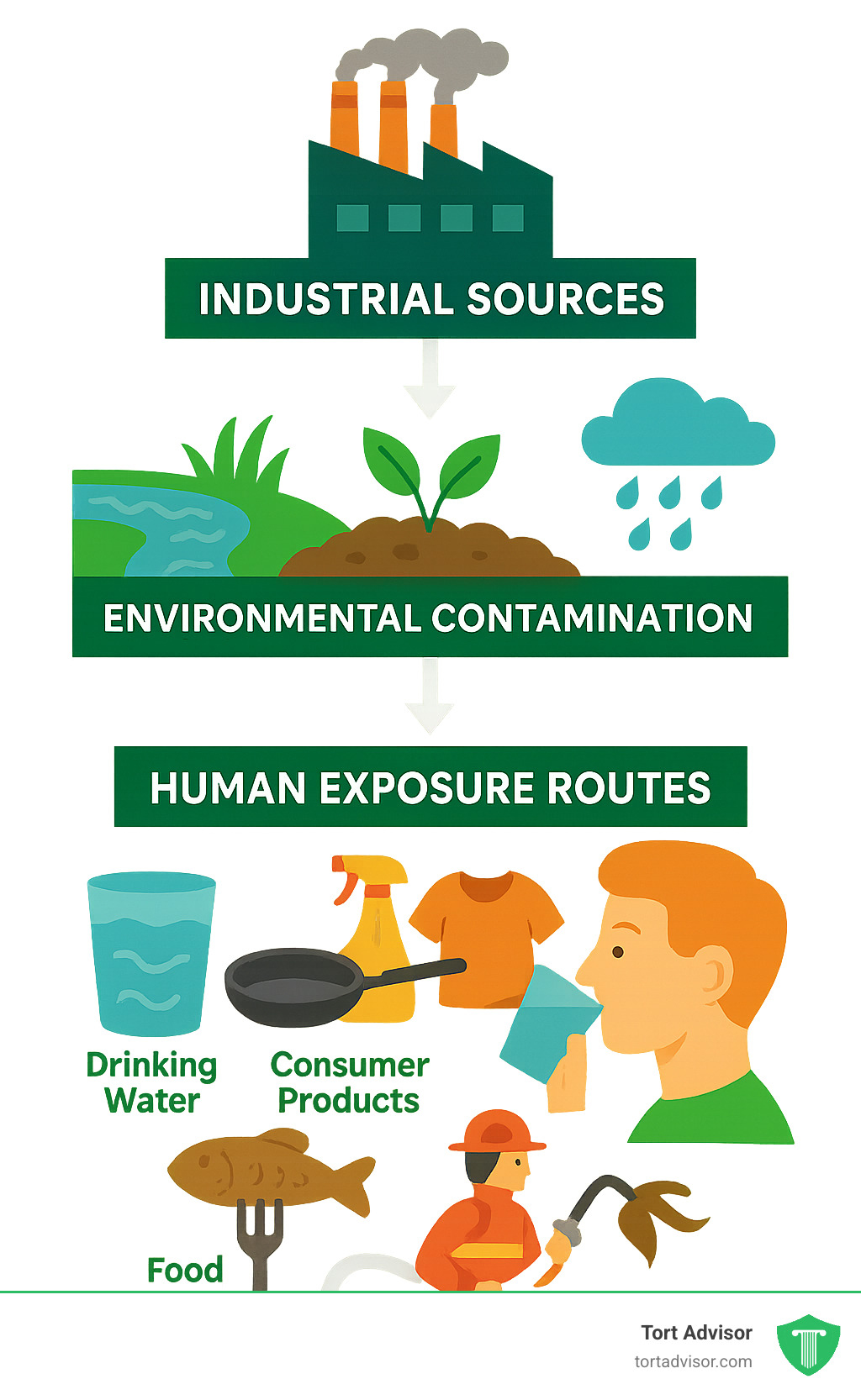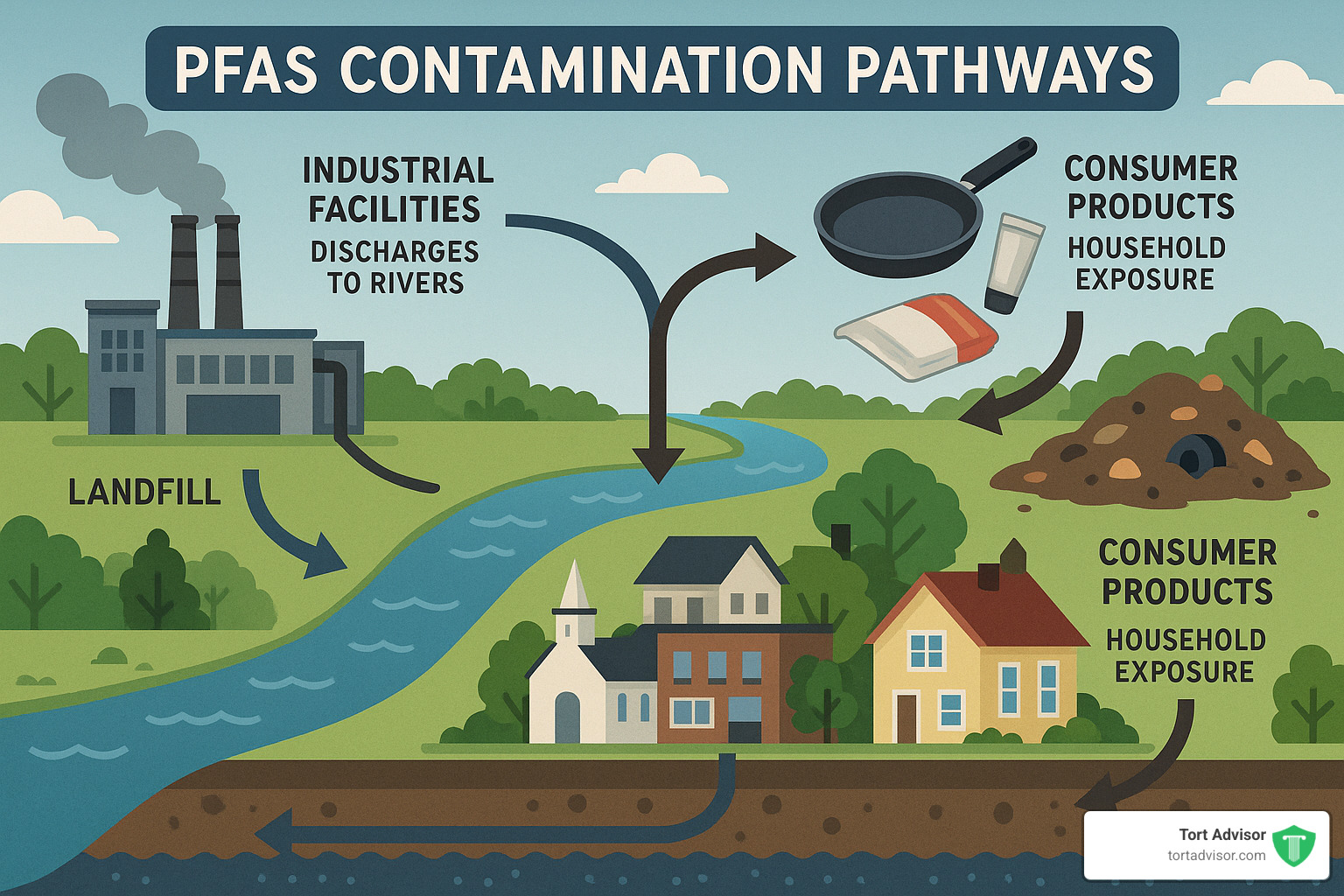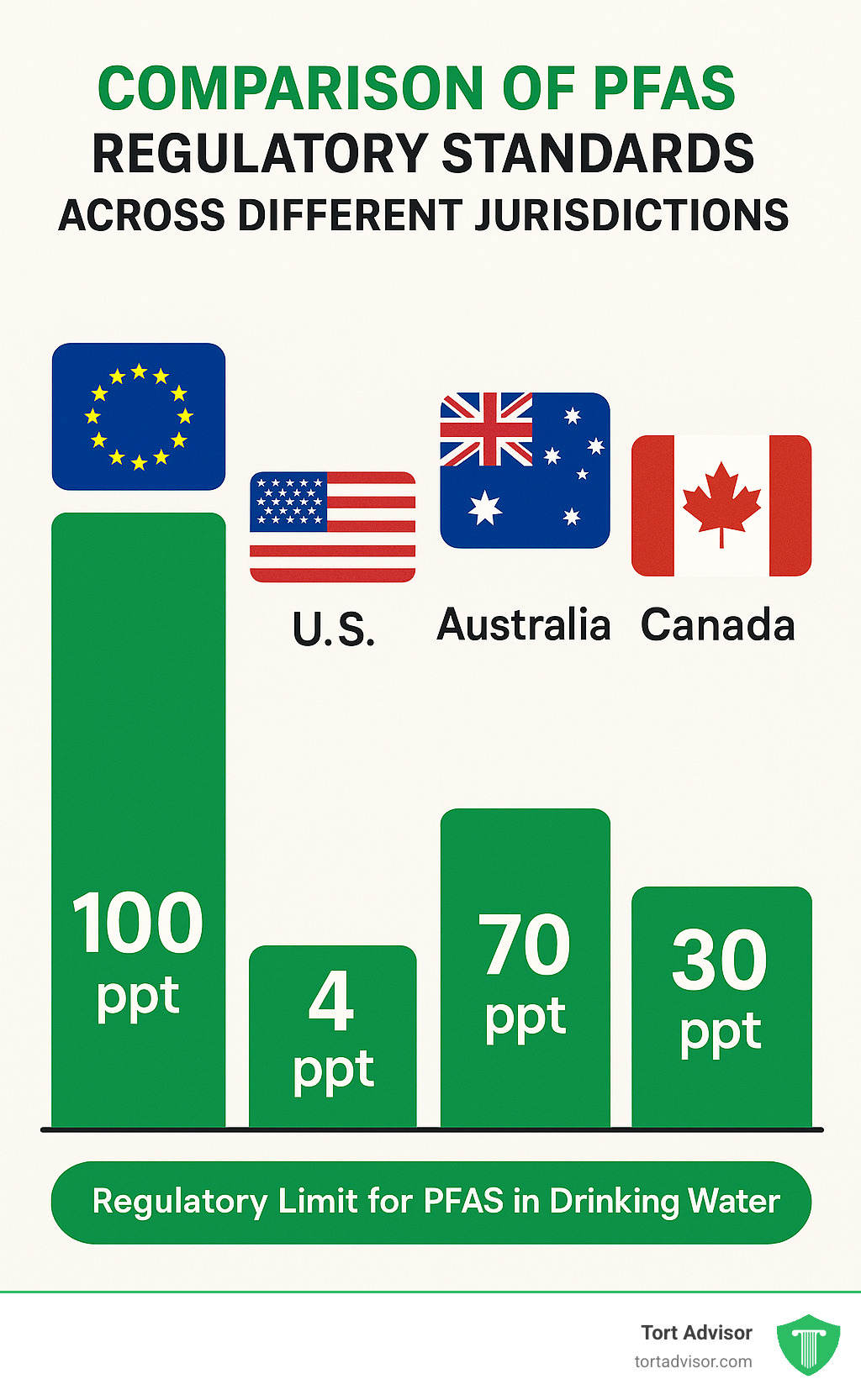


Understanding the Hidden Dangers in Our Environment
PFAS exposure risks are a growing public health concern affecting millions of Americans through contaminated drinking water, food, consumer products, and occupational settings. These synthetic chemicals have been linked to serious health problems that everyone should be aware of.
Key PFAS Exposure Risks:
- Drinking water contamination – One of the most common exposure routes
- Consumer products including non-stick cookware, water-resistant clothing, and food packaging
- Occupational exposure particularly for firefighters using foam containing PFAS
- Food chain contamination through agricultural soils and fish from polluted waters
Health effects associated with PFAS exposure include:
- Increased cholesterol levels
- Changes in liver enzyme levels
- Decreased vaccine response in children
- Increased risk of kidney and testicular cancer
- Pregnancy complications including preeclampsia
- Developmental delays in children
Often called “forever chemicals,” PFAS (per- and polyfluoroalkyl substances) include more than 4,700 different compounds that persist in the environment and human body for years or even decades. These chemicals resist degradation due to their strong carbon-fluorine bonds, leading to widespread contamination across soil, water, and even human blood samples.
The U.S. Environmental Protection Agency recently established stricter drinking water regulations for certain PFAS compounds, recognizing the serious public health threat they pose. Despite these measures, many Americans remain unaware of their exposure and the potential long-term health consequences.
My name is Mason Arnao, and while my background is in technology and software development, I’ve researched PFAS exposure risks extensively after finding contamination in my community’s water supply, working with environmental scientists to understand these persistent chemicals and their impact on public health.

What Are PFAS? The “Forever Chemicals” Defined
Ever wonder why your raincoat repels water so effectively or why food doesn’t stick to your favorite pan? The answer likely involves PFAS – a family of human-made chemicals with some remarkable properties and concerning health implications.
PFAS (per- and polyfluoroalkyl substances) are defined by their carbon chains bonded to multiple fluorine atoms. What makes these chemicals special – and problematic – is the carbon-fluorine bond, which is one of the strongest bonds in organic chemistry. This exceptional strength is both a blessing for industrial applications and a curse for our environment and health.
Today, there are more than 4,700 different PFAS compounds circulating worldwide, with manufacturers developing new variations as older ones face regulatory scrutiny. Scientists typically divide these chemicals into two main categories:
- Long-chain PFAS: These contain 8-20 perfluorinated carbon atoms and include the notorious PFOA (perfluorooctanoic acid) and PFOS (perfluorooctane sulfonic acid). They’re more likely to build up in our bodies and have stronger links to health problems.
- Short-chain PFAS: Developed as “safer” alternatives with fewer carbon atoms, these chemicals still persist in the environment and may pose health risks that researchers are still uncovering.
Due to mounting evidence of their dangers, several PFAS compounds including PFOA and PFOS have been listed under the Stockholm Convention on Persistent Organic Pollutants, an international treaty designed to protect human health and the environment from particularly harmful chemicals. For deeper insights into their chemical structure and behavior, scientific research on PFAS chemistry provides valuable information.
Why They’re Called “Forever Chemicals”
The nickname “forever chemicals” isn’t just clever marketing – it’s a frighteningly accurate description of how PFAS behave in our world. These substances are remarkably stubborn once released into the environment:
They persist indefinitely with no natural processes capable of breaking them down completely. PFAS released decades ago are still present in our environment today.
They bioaccumulate in wildlife and humans, meaning their concentrations increase over time as exposure continues.
They resist typical environmental degradation processes including heat, water, and microbial action that would normally break down other pollutants.
This extraordinary persistence explains why scientists have detected PFAS in places far from any industrial sources – from remote Arctic snow to deep ocean trenches – demonstrating how these chemicals travel globally through water and air currents.
Common Uses Across Industries
The unique properties of PFAS have made them valuable across numerous industries, which explains their widespread presence in our lives:
Firefighting foam (AFFF) contains PFAS to smother fuel fires quickly, particularly at military bases, airports, and firefighter training facilities.
Textiles and carpeting incorporate PFAS to create stain-resistant and water-repellent fabrics that keep your furniture and clothes looking newer longer.
Food packaging uses PFAS for grease and water resistance in fast-food wrappers, microwave popcorn bags, and pizza boxes.
Non-stick cookware relies on PFAS coatings to create slippery surfaces that prevent food from sticking.
Electronics manufacturing employs PFAS in the production of semiconductors and other components.
Cosmetics and personal care products contain PFAS to add water resistance and smooth application properties.
Medical devices use PFAS coatings to reduce friction and improve performance.
This widespread industrial use explains why the CDC has found PFAS exposure risks in the blood of 97% of Americans tested. These chemicals have become nearly impossible to avoid in modern life, creating an invisible web of exposure that affects virtually everyone.
As we’ll explore in the following sections, understanding where these chemicals come from is just the first step in protecting yourself and your family from their potential health effects.
How PFAS Enter Our World and Bodies

When I first learned about PFAS exposure risks, I was shocked by how these chemicals manage to infiltrate nearly every aspect of our lives. These “forever chemicals” don’t stay put in the products we use—they start on a troubling journey through our environment and eventually into our bodies.
Think of PFAS contamination as a complex web with multiple entry points. Manufacturing facilities release PFAS directly into water and air during production. Firefighting training areas, especially at military bases and airports, repeatedly saturate the ground with AFFF foam. Our landfills become PFAS reservoirs as we discard everything from old non-stick pans to stain-resistant carpeting. Even wastewater treatment plants—designed to clean our water—can spread PFAS when their biosolids are applied to agricultural land. And in our homes, everyday products slowly release these chemicals during normal use.
Environmental Transport & Persistence
What makes PFAS particularly troubling is their remarkable mobility once released. Unlike many contaminants that stay relatively local, PFAS are world travelers.
In water systems, these chemicals dissolve readily and hitch rides through groundwater, streams, rivers, and eventually oceans. A 2023 study confirmed what many scientists feared—PFAS have now been detected in surface waters on every continent, including pristine areas far from industrial activity.
Some PFAS compounds don’t just stick to water—they become airborne, catching atmospheric currents that carry them thousands of miles before raining down in distant locations. Even soil can’t trap these slippery substances. While many pollutants bind to soil particles, PFAS exposure risks increase because these chemicals move freely downward, eventually reaching groundwater supplies.
The most alarming aspect? Their staying power. If we stopped all PFAS production today, we’d still be dealing with existing contamination for generations—possibly centuries—to come. These chemicals simply refuse to break down through natural processes that would normally decompose other pollutants.
Main Pathways of PFAS Exposure Risks
For most of us, drinking water represents the most significant exposure route. The EPA estimates about 100 million Americans consume PFAS-contaminated water, with highest concentrations near industrial facilities, military bases, and airports. Every sip potentially adds to your body burden of these chemicals.
Our food supply offers another major pathway. PFAS enter our meals through contaminated agricultural soils and irrigation water. They migrate from food packaging into our takeout and microwave popcorn. They bioaccumulate in fish and seafood from polluted waters. Even dairy and meat products can contain PFAS when livestock consume contaminated feed or water.
Inside our homes, PFAS exposure risks continue as household products shed these chemicals into dust. This exposure particularly affects young children who frequently put hands in their mouths after touching floors and surfaces.
Workers in certain industries face liftd exposure through inhaling PFAS-containing dust or fumes, skin contact with PFAS materials, and accidental ingestion during manufacturing processes. Firefighters face particularly high risks when using AFFF foam.
Perhaps most heartbreaking is how PFAS affects our most vulnerable—PFAS can cross the placenta during pregnancy and transfer to infants through breast milk, potentially impacting the earliest and most critical stages of human development.
Understanding these pathways helps explain why PFAS are detectable in nearly all Americans’ blood, regardless of lifestyle or location. This widespread contamination underscores why addressing PFAS exposure risks requires both strong regulatory action and informed personal choices to protect ourselves and our families.
Understanding PFAS Exposure Risks to Human Health

When I first learned about PFAS chemicals, I was shocked by how deeply they can affect our bodies. These aren’t substances that simply pass through us—they stick around, interacting with our biological systems in ways that can throw normal functions off balance and potentially lead to serious health problems.
Scientific research has painted an increasingly clear picture of how PFAS exposure risks impact our health. Even at relatively low levels, these chemicals can raise your cholesterol, potentially increasing your risk of heart disease. Your liver isn’t spared either—researchers have observed changes in liver enzymes and potential damage in people with higher exposure levels.
Perhaps most concerning is how PFAS can suppress your immune system. This isn’t just theoretical—studies show these chemicals can reduce your body’s antibody response to vaccines, potentially leaving you more vulnerable to infections. And yes, cancer is a real concern too. Epidemiological studies have linked PFAS exposure to increased risks of kidney and testicular cancers, with the International Agency for Research on Cancer classifying PFOA (a common PFAS compound) as a human carcinogen in 2023.
For expectant mothers, the news isn’t reassuring. PFAS exposure has been connected to decreased fertility, pregnancy-induced hypertension, preeclampsia, and slight decreases in birth weight. These chemicals don’t play nice with your thyroid either, interfering with normal hormone function that regulates everything from your metabolism to proper development. Some research even suggests PFAS may contribute to obesity and conditions like diabetes.
Short- and Long-Term Health Effects
The timeline of PFAS health impacts varies considerably. In the short term, you might experience subtle changes in liver enzyme levels, shifts in your cholesterol profile, or modest modifications to your immune system. These might not be noticeable in your daily life but can be detected through blood tests.
The long-term picture is more troubling. Because PFAS accumulate in your body over time, years or decades of exposure can lead to chronic diseases with long latency periods. Cancer risk increases gradually, and various organ systems may suffer cumulative damage. This long delay between exposure and disease makes establishing direct cause-and-effect relationships challenging, which is precisely why many health experts advocate for a precautionary approach to regulating these substances.
Factors Influencing PFAS Exposure Risks
Not everyone exposed to PFAS will develop health problems. Your personal risk depends on several key factors:
How much and how long you’re exposed matters tremendously—higher concentrations and extended exposure periods generally increase your risk. Your age during exposure is equally important, with developing fetuses, babies, and young children typically more vulnerable to PFAS effects.
Your genetic makeup plays a role too, as individual variations can affect how your body processes and responds to these chemicals. And it’s not just about PFAS alone—exposure to multiple PFAS compounds or other environmental contaminants may create synergistic effects that amplify harm. Even your lifestyle choices like diet and exercise might modify your PFAS-related health risks.
Populations at Highest Risk
While most of us have some level of PFAS in our bodies, certain groups face substantially higher PFAS exposure risks. Firefighters regularly using AFFF foam show significantly liftd PFAS blood levels compared to the general population. Workers in chemical plants manufacturing these substances have some of the highest documented exposure levels anywhere.
Military personnel stationed at bases where firefighting foam was regularly used often face higher exposure, particularly those directly involved in firefighting activities. If you live near a PFAS manufacturing plant, military base, airport, or other site with heavy PFAS use, you may face higher exposure through contaminated drinking water and air.
Infants and young children are especially vulnerable due to their developing bodies, higher water consumption relative to their size, and natural hand-to-mouth behaviors. Pregnant women face unique concerns as PFAS can cross the placenta, potentially affecting fetal development during critical periods.
A particularly eye-opening study on serum PFAS levels and kidney cancer in the Multiethnic Cohort found that PFAS associations with cancer risk varied across racial and ethnic groups. This highlights how important it is to study diverse populations when assessing PFAS exposure risks—what affects one community may impact another differently.
Understanding these health risks isn’t just academic—it’s essential knowledge for protecting yourself and your loved ones in a world where these chemicals have become ubiquitous. As we continue learning more about PFAS, the case for caution and informed decision-making only grows stronger.
Detecting, Measuring & Regulating PFAS
Finding these invisible threats in our water, food, and even our bodies is no small feat. As someone who’s followed the PFAS story closely, I can tell you that scientists have made remarkable progress in detecting these elusive chemicals, though challenges remain.
Think about this: we’re now able to detect substances at concentrations as tiny as parts per trillion. That’s like finding a single drop in 20 Olympic-sized swimming pools!
The most reliable method scientists use is Liquid Chromatography-Mass Spectrometry (LC-MS/MS), which serves as the gold standard for pinpointing specific PFAS compounds. For a broader picture, researchers turn to the Total Oxidizable Precursor (TOP) Assay, which cleverly converts precursor chemicals into measurable end products.
Exciting innovations are happening too. New optical and electrochemical sensors promise faster, field-ready detection capabilities that could revolutionize how we monitor PFAS exposure risks in communities. Meanwhile, biomonitoring – measuring PFAS in blood samples – helps scientists understand how these chemicals accumulate in our bodies over time.

Current U.S. and Global Standards
The regulatory landscape for PFAS has transformed dramatically in recent years as science has caught up with these persistent chemicals. In a watershed moment, the EPA established meaningful limits in 2024, setting drinking water standards of just 4 parts per trillion for both PFOA and PFOS – the two most studied PFAS compounds. They’ve also implemented a mixture-based approach for several other concerning compounds including PFNA, PFHxS, and GenX.
What’s fascinating is how states have sometimes moved ahead of federal regulations. New Hampshire set its own standards: 12 ppt for PFOA, 15 ppt for PFOS, 18 ppt for PFHxS, and 11 ppt for PFNA. Michigan and California have their own limits too, showing how PFAS exposure risks are being addressed differently across the country.
Across the Atlantic, the European Union has proposed a combined limit of 100 ppt for a group of 20 PFAS compounds in drinking water, taking more of a cumulative approach.
These new EPA regulations represent a major public health victory, potentially protecting about 100 million Americans from the most harmful PFAS compounds. It’s a significant step forward, even if the patchwork of regulations reflects the complex science and politics surrounding these chemicals.
Challenges & Research Gaps
Despite impressive progress, we’re still very much in the middle of the PFAS story, not the end. Scientists studying PFAS exposure risks face several stubborn challenges.
First, while PFOA and PFOS have received the lion’s share of attention, thousands of other PFAS compounds remain mysterious, with limited or no toxicity data. It’s like focusing on two trees while standing in a vast forest.
Another complication is that real-world exposure rarely involves just one PFAS compound. We’re typically exposed to a complex mixture, yet regulations often address chemicals individually. This gap between reality and regulation needs bridging.
Long-term health studies present another hurdle. As one researcher put it, “We’re still finding new PFAS compounds in the environment faster than we can assess their toxicity.” This is especially true for newer replacement PFAS chemicals that were supposed to be safer alternatives.
Our detection methods, impressive as they are, still can’t catch all PFAS compounds, potentially underestimating total exposure. And perhaps most intriguingly, individuals seem to process these chemicals differently – why some people might be more vulnerable than others remains an open question in scientific research on PFAS detection.
These knowledge gaps underscore why many scientists advocate for a precautionary approach to PFAS regulation. After all, when it comes to chemicals that can persist for generations, better safe than sorry seems like wisdom, not paranoia.
Reducing Your Exposure & Community Action
Let’s face it—we can’t completely escape PFAS in today’s world. These chemicals have become so ubiquitous that avoiding them entirely would require living in a bubble! But don’t worry, there’s plenty we can do to minimize our PFAS exposure risks while still living a normal life.
Practical Steps for Households
Your home should be your sanctuary, not a source of chemical exposure. Installing a reverse osmosis (RO) filtration system is one of the most effective ways to protect your drinking water, removing up to 99% of PFAS contaminants. If that’s beyond your budget right now, dual-stage filters with activated carbon can also make a significant difference. Just remember—contrary to what many believe, boiling water doesn’t eliminate PFAS and might actually concentrate them further!
When it comes to mealtimes, small changes can make a big difference. That greasy burger wrapped in coated paper? It might be delivering more than just calories. Whenever possible, choose food with minimal packaging or ask for alternatives. In your own kitchen, ditch the non-stick cookware in favor of stainless steel, cast iron, or ceramic options. Your food will taste just as good without the unwanted chemical seasoning!
I was surprised to learn how many everyday products contain PFAS—from waterproof mascara to stain-resistant furniture. Becoming a label detective helps tremendously here. Look specifically for items marked “PFAS-free” and be wary of ingredients containing “perfluoro” or “polyfluoro” in the fine print. Even microwave popcorn has gotten a makeover, with many brands now offering PFAS-free packaging options.
Dust might seem harmless, but it’s actually a significant source of PFAS exposure risks, especially for children who play on floors and frequently put hands in mouths. Vacuuming with HEPA filters and using wet dusting methods can dramatically reduce this exposure pathway. And yes, that age-old parental advice to “wash your hands before eating” turns out to be excellent PFAS-prevention advice too!
For those who know they’ve had significant PFAS exposure, some medical interventions might help. Regular blood or plasma donation has shown promising results in reducing PFAS levels—an Australian study of firefighters found that those who donated blood for over a year had significantly lower PFAS in their bloodstream. Some doctors also prescribe cholestyramine to accelerate PFAS elimination, though this requires medical supervision.
Legal Options and Advocacy
Protecting your family is important, but tackling PFAS exposure risks is truly a community challenge. Start by requesting PFAS testing from your local water utility if they don’t already provide this information. The results might surprise you—and motivate your neighbors to join forces in demanding better protection.
Community organizing creates powerful momentum. When you join forces with others facing similar concerns, solutions become more accessible. Share information about testing resources, split the costs of water analysis, or coordinate bulk purchases of filtration systems to make them more affordable for everyone.
The EPA regularly accepts public comments on proposed regulations, giving you a direct voice in how these chemicals are managed. Taking five minutes to submit your perspective through the Federal Register or Regulations.gov might feel like a drop in the bucket, but these comments genuinely influence regulatory decisions.
For communities experiencing significant contamination and health impacts, legal recourse may be appropriate. At Tort Advisor, we connect affected individuals with attorneys experienced in PFAS litigation, including PFAS Cancer Lawsuits and AFFF Firefighting Foam Lawsuits. These legal actions have successfully secured compensation for medical monitoring, property damage, and personal injury in communities affected by PFAS contamination.
Supporting policy change creates lasting protection. When you advocate for stronger PFAS regulations, product labeling requirements, and cleanup standards, you’re helping create a safer environment for generations to come. Even small actions like contacting your representatives or attending a local council meeting can contribute to meaningful change.
By combining personal exposure reduction with community advocacy, we can protect ourselves today while working toward a future where checking for “forever chemicals” isn’t necessary. After all, clean water isn’t a luxury—it’s a basic right we all deserve.
Frequently Asked Questions about PFAS Exposure Risks
Are PFAS in my blood dangerous?
Finding out you have PFAS exposure risks in your bloodstream can be alarming. With these chemicals detectable in about 97% of Americans, it’s a concern many of us share.
The truth is, having PFAS in your blood doesn’t automatically mean you’ll experience health problems. Think of it more as evidence that you’ve been exposed to these persistent chemicals that are unfortunately all around us. Whether this exposure might affect your health depends on several important factors.
The concentration matters significantly – higher blood levels generally suggest greater exposure and potentially higher risk. The specific types of PFAS detected also make a difference, with compounds like PFOA and PFOS having stronger evidence linking them to health issues than others. Your personal factors play a role too – your age, genetic makeup, and overall health status all influence how these chemicals might affect you. And of course, how long you’ve been exposed matters, with longer periods potentially increasing your risk.
If you’re worried about PFAS in your blood, consider taking some practical steps. Start by identifying possible exposure sources in your daily environment. Then work on reducing your ongoing exposure through the methods we’ve discussed. It’s also worth having a conversation with your healthcare provider, who might recommend monitoring for conditions associated with PFAS exposure. For those with particularly high levels, regular blood donation might actually help reduce the amount of PFAS in your body over time.
Unfortunately, there’s no medical treatment specifically designed to remove PFAS from your body. While your body naturally eliminates some PFAS over time, this process can take years for certain compounds – which is why they earned that troubling “forever chemicals” nickname in the first place.
Does boiling water remove PFAS?
Here’s a crucial fact many people misunderstand: boiling water does not remove PFAS. In fact, it can make the situation worse by concentrating these chemicals as water evaporates while the PFAS remains behind.
It’s a natural assumption that boiling would purify water of all contaminants. While boiling effectively kills biological threats like bacteria and viruses, it simply doesn’t work on chemical contaminants like PFAS, lead, or arsenic. The heat isn’t enough to break down or remove these substances.
If you’re concerned about PFAS in your drinking water, you’ll need to use specific filtration methods. Reverse osmosis (RO) systems are the most effective option, capable of removing up to 99% of PFAS. Activated carbon filters can also work well, especially for longer-chain PFAS compounds. Other effective options include ion exchange treatment systems and nanofiltration, though their effectiveness varies depending on the specific PFAS compounds present.
My recommendation if you’re worried about PFAS in your water is to first get it tested specifically for these chemicals, as standard water tests typically don’t include PFAS screening. Based on those results, install appropriate filtration. And if you’re in a high-risk area, consider using bottled water from tested sources as a temporary measure while you work on a long-term solution.
Should I worry about PFAS while breastfeeding?
This question touches on something deeply personal for many new parents. The science tells us that PFAS can transfer from mother to infant through breast milk, and researchers have indeed found various PFAS compounds in breast milk samples worldwide.
Despite this concerning fact, health organizations including the CDC and WHO continue to recommend breastfeeding. Their guidance reflects a careful weighing of known benefits against potential risks. The immunity, nutritional, and developmental benefits of breastfeeding are well-established and substantial. By contrast, preparing formula with PFAS-contaminated water could potentially result in similar or even greater exposure. There’s also evidence suggesting that many of the developmental benefits of breastfeeding may actually help counteract some potential effects of PFAS exposure risks.
If you’re breastfeeding and concerned about PFAS, there are steps you can take to reduce your baby’s exposure. Focus first on identifying and reducing your own exposure sources where possible, since your exposure directly affects what passes through your breast milk. Consider testing your home water and installing appropriate filtration if needed. And of course, discuss any specific concerns with your pediatrician who can offer personalized guidance.
The scientific consensus remains reassuring: based on current evidence, the benefits of breastfeeding appear to outweigh the potential risks of PFAS exposure through breast milk. Decisions about breastfeeding duration should take multiple factors into account beyond just PFAS concerns.
Conclusion
The issue of PFAS exposure risks represents one of the most significant environmental health challenges of our time. These “forever chemicals” have silently worked their way into our environment, our products, and ultimately our bodies, creating potential health consequences that may span generations.
Throughout this guide, we’ve seen how the widespread nature of PFAS contamination means almost everyone has been exposed to some degree. But here’s the good news – knowledge truly is power. Understanding these risks allows you to take meaningful steps to protect yourself and your loved ones.
At Tort Advisor, we believe in giving people both information and options. For many communities facing significant PFAS contamination, legal action can be an important part of addressing both personal health concerns and broader environmental justice issues. Our network of experienced attorneys specializes in connecting affected individuals with legal representation for PFAS Cancer Lawsuits and other PFAS-related litigation.
Looking back at what we’ve learned about PFAS exposure risks, several important points stand out:
First, while PFAS contamination is widespread, it’s not uniform. Some communities – particularly those near industrial facilities, military bases, and airports – face substantially higher exposure levels than others. If you live in one of these areas, being proactive about testing and filtration becomes even more crucial.
Second, the health effects of PFAS are becoming increasingly clear. Scientific evidence continues to strengthen the links between PFAS exposure and serious health outcomes including cancer, immune dysfunction, and metabolic changes. This isn’t just theoretical – it’s affecting real people in communities across the country.
Third, while regulatory progress is happening, it remains incomplete. The EPA’s 2024 drinking water standards represent significant progress, but comprehensive regulation of the thousands of PFAS compounds remains a challenge. This regulatory gap makes personal vigilance all the more important.
Fourth, your personal actions really do make a difference. Installing appropriate water filtration, making informed consumer choices, and staying informed about local contamination can significantly reduce your PFAS exposure. Small changes in your daily routine can add up to meaningful protection.
Finally, community advocacy matters tremendously. Some of the most significant progress in addressing PFAS contamination has come from neighbors organizing together, applying public pressure, and taking collective legal action when necessary.
The path forward requires a blend of individual vigilance, community action, regulatory oversight, and when necessary, legal accountability for those responsible for significant contamination. By staying informed and engaged, you can protect yourself while contributing to broader solutions for this persistent environmental health challenge.
If you believe you’ve been affected by PFAS contamination and are experiencing health issues, we’re here to help. Our team at Tort Advisor can connect you with attorneys experienced in PFAS litigation who understand both the complex science and legal landscape surrounding these cases. You don’t have to steer these waters alone.
Free Confidential Case Evaluation
Complete the short form below to get an immediate FREE case review with an expert in your specific claim. Don't wait, your case could be time sensitive to file a claim.
Related Posts
Did a North Dakota product cause harm? Understand product liability, your rights, and how to take action for defects.
Get justice for clergy abuse. Find an expert Priest abuse lawyer to navigate complex laws and hold institutions accountable.
Diagnosed with meningioma after Depo-Provera? Understand potential Depo-Provera lawsuit settlements, risks, & how to claim compensation.
Uncover the truth about uber sexual assault cases. Learn about the alarming scale, Uber's accountability, and legal options for justice.
Facing wildfire losses? Discover the best wildfire lawsuit attorneys in California to fight for your full recovery and justice.
Exposed to Roundup & diagnosed with NHL? Discover how to sue Monsanto, understand eligibility, & seek compensation. Your guide to justice.






